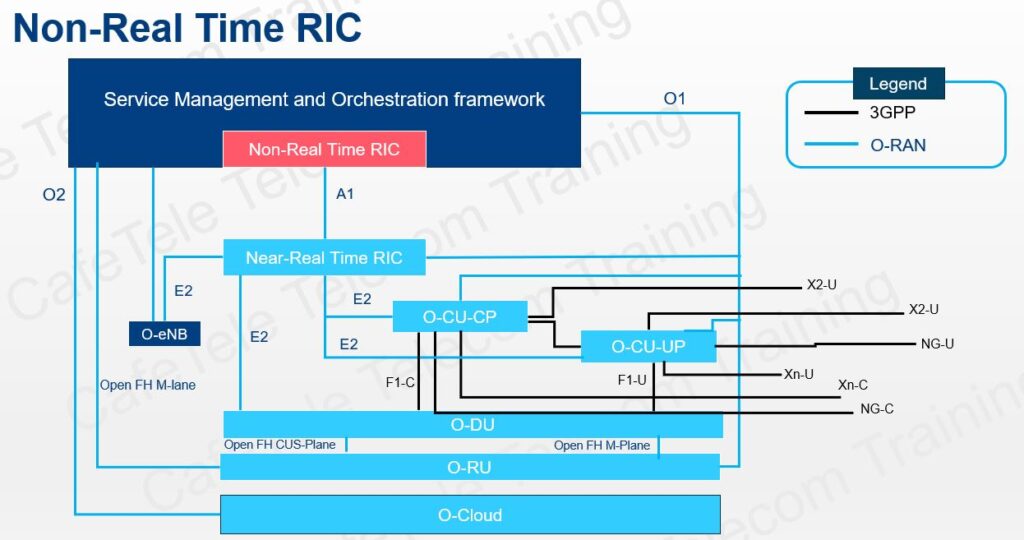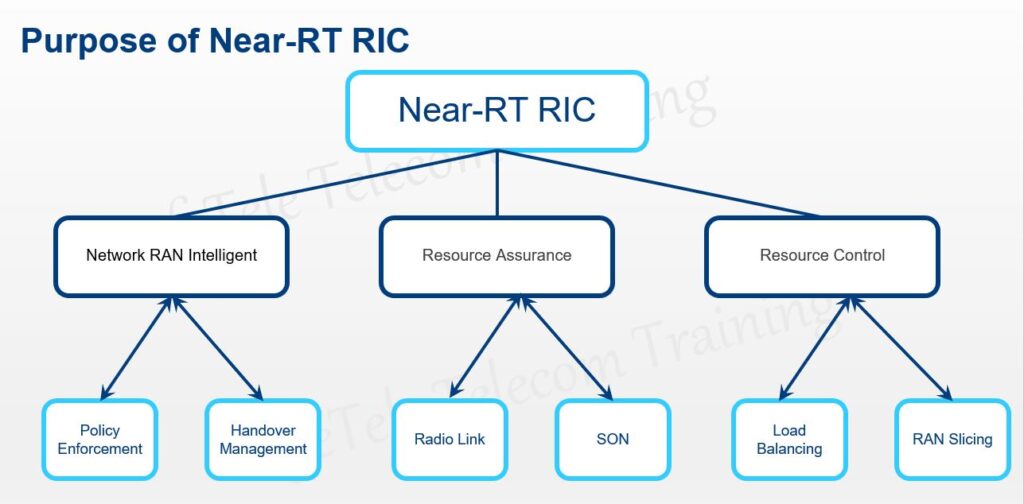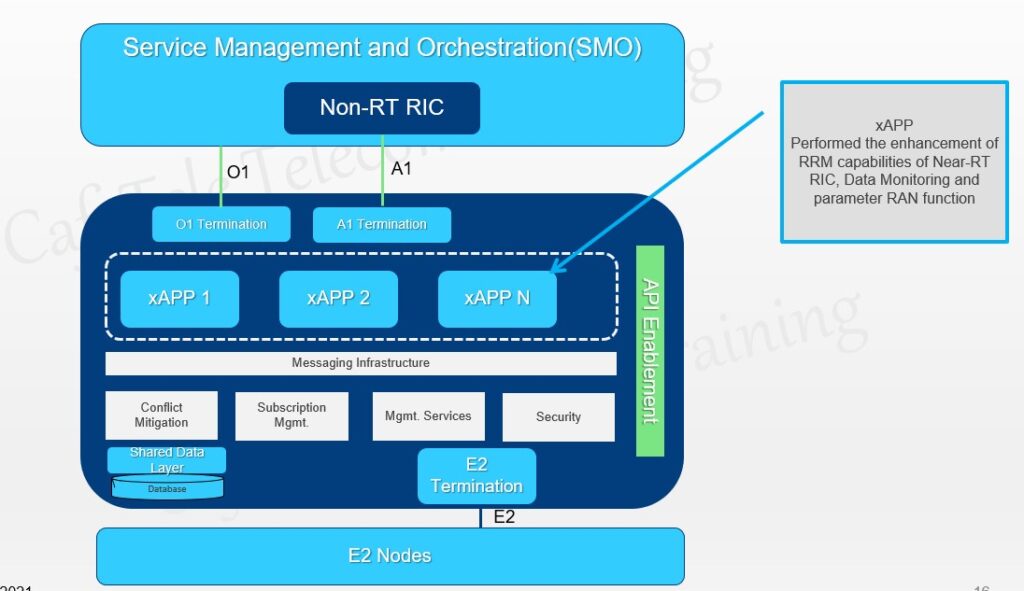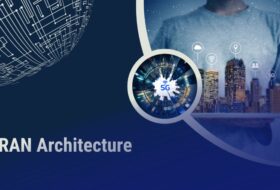What is RIC(Ran Intelligent Controller)?
- Near-RT RIC(O-RAN Near-Real-Time RAN Intelligent Controller: A logical function that enables near-real-time control and optimization of RAN elements and resources via fine-grained data collection and actions over E2 interface.)
- Non-RT RIC(O-RAN Non-Real-Time RAN Intelligent Controller: A logical function within SMO that drives the content carried across the A1 interface. It is comprised of the Non-RT RIC Framework and the Non-RT RIC Applications).
For those unfamiliar with O-RAN Architecture, you can explore it in more detail by following this link: O-RAN Architecture



General Principle Near-RT RIC
The Near-RT RIC architecture and internal interfaces shall be open to support 3rd party xApps. Near-RT RIC shall consist of multiple xApps and a set of platform functions that are commonly used to support the specific functions hosted by xApps.
Near-RT RIC Architecture:
- xApp
- Security
- Messaging infrastructure
- Subscription Management
- Management Services
- Conflict mitigation

Near-RT RIC Function :
Near-RT RIC hosts the following functions:
- Database, which allows reading and writing of RAN/UE information
- xApp subscription management, which merges subscriptions from different xApps and provides unified data distribution to xApps
- Conflict mitigation,which resolves potentially overlapping or conflicting requests from multiple xApps
- Messaging infrastructure,which enables message interaction amongst Near-RT RIC internal functions
- Security,which provides the security scheme for xApps
Management Services:
- Fault management, configuration management, and performance management as a service producer to SMO;
- Life-cycle management of xApps;
- Logging, tracing and metrics collection, which captures, monitor, and collect the status of Near-RT RIC internals and can be transferred to an external system for further evaluation
Interface Termination:
- E2 termination, which terminates E2 interface from an E2 Node;
- A1 termination, which terminates A1 interface from Non-RT RIC;
- O1 termination, which terminates O1 interface from SMO
-
Functions hosted by xApps, which allow services to be executed at Near-RT RIC and outcomes to be sent to E2 Nodes via E2 interface;
-
API enablement function supporting capabilities related to Near-RT RIC API operations (API repository/registry, authentication, discovery, generic event subscription, etc.)
xApp Requirements
- xAppmay enhance the RRM capabilities of Near-RT RIC.
- xAppmay be associated with zero, one or more E2SMs.
- xAppshall use Near-RT RIC APIs to make use of the Information Elements (IEs) of E2SMs that are associated with it.
- xAppthat is associated with a given E2SM shall be able to interface with any E2 Node that supports that E2SM without any intermediary xApp.
- xAppshall be able to receive event-triggered information on RAN information and time-varying network state.
- xAppshall provide collected logging, tracing and metrics information to Near-RT RIC.
- xAppshall provide a descriptor that includes the following basic information of the xApp:
Configuration: It includes a data dictionary for configuration data, i.e., meta data such as a YANG definition or a list of configuration parameters and their semantics. It may also include an initial configuration of xApp.
Control: It includes the types of data that an xApp consumes and generates, in order to perform control capabilities (e.g., xApp URL, parameters, input/output type).
Metrics: It includes a list of metrics (e.g., metric name, type, unit and semantics) provided by the xApp.
- The xApp descriptor shall also provide the necessary data to enable management and orchestration of the xApp, aligned with [4].
- xApps shall communicate with Near-RT RIC platform via Near-RT RIC APIs.
- xApp shall register the Near-RT RIC APIs it produces. xApp shall be capable of discovering the Near-RT RIC APIs they consume
Near-RT RIC API Requirements
- Near-RT RIC shall provide APIs enabling the hosting of 3rd party xApps and xApps from the Near-RT RIC platform vendor.
- Near-RT RIC APIs shall not adversely impact low-latency and high throughput operations of Near-RT RIC. Specifically, the Near-RT RIC APIs shall support the Near-RT RIC control loop of execution time from 10 milliseconds to 1 second.
- Near-RT RIC shall provide APIs decoupled from specific implementation solutions, including a Shared Data Layer (SDL) that works as an overlay for underlying databases and enables simplified data access.
- Near-RT RIC shall provide an API repository/registry for the services provided by the Near-RT RIC platform and/or xApps.
- Near-RT RIC shall provide means for xApps to discover the published APIs based on the xApps’ needs.
- Near-RT RIC shall provide means to restrict xApps from discovering some published APIs based on configured policies.
- Near-RT RIC shall provide APIs enabling all xApps to directly use the information elements of E2SMs with which they are associated.
- Near-RT RIC shall provide APIs aiming to simplify the development of xApps and enable rapid innovation.
- Near-RT RIC shall provide Near-RT RIC APIs supporting xApp development in multiple programming languages (e.g. C, C++, Python, Go). Near-RT RIC APIs shall support xApp subscription management based on operators’ policies. An xApp may be restricted to interface with only a subset of E2 Nodes by such policies.
- Near-RT RIC shall be responsible for routing messages between this xApp and the subset of E2 Nodes.



